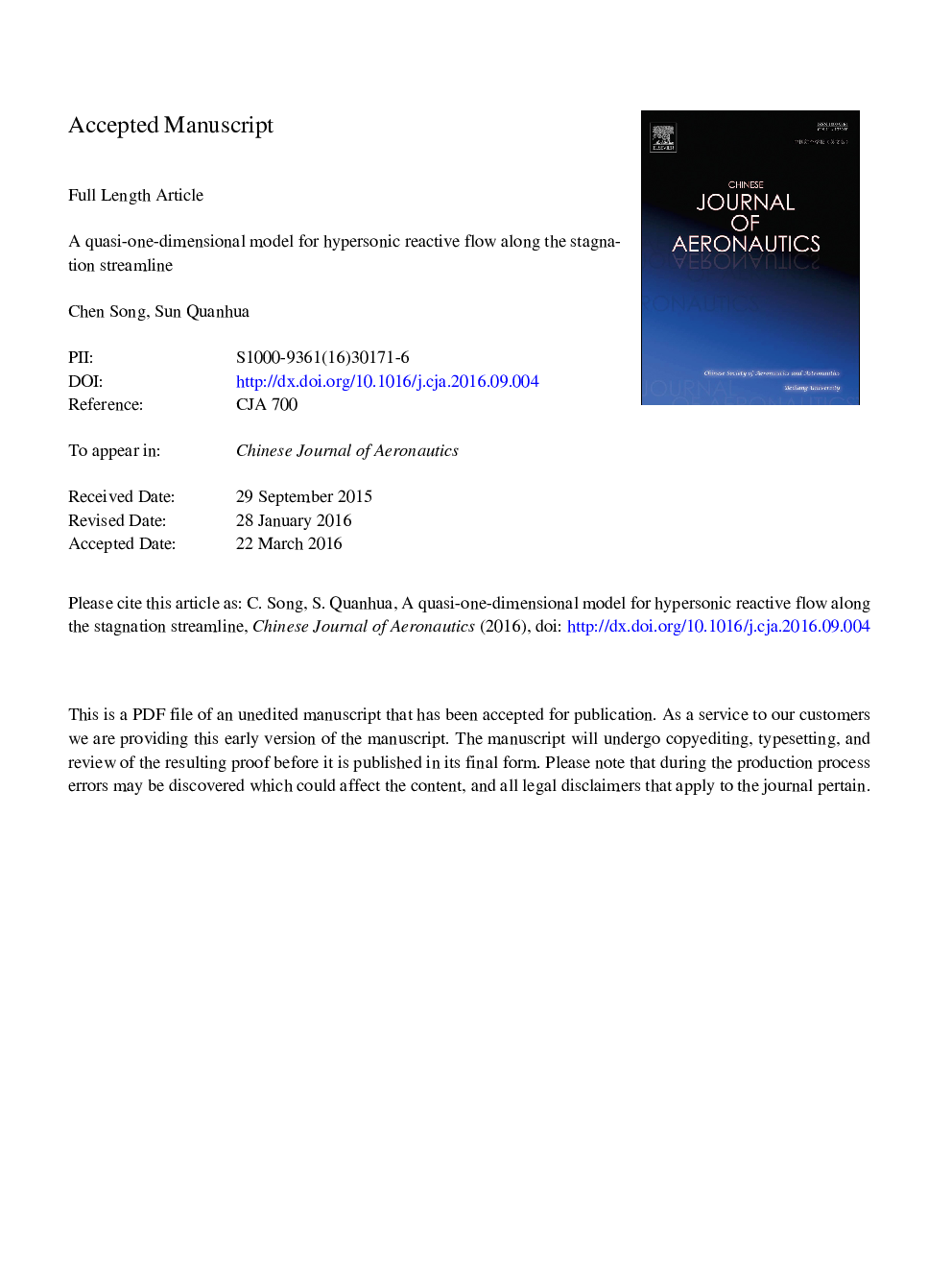| کد مقاله | کد نشریه | سال انتشار | مقاله انگلیسی | نسخه تمام متن |
|---|---|---|---|---|
| 7154235 | 1462498 | 2016 | 13 صفحه PDF | دانلود رایگان |
عنوان انگلیسی مقاله ISI
A quasi-one-dimensional model for hypersonic reactive flow along the stagnation streamline
ترجمه فارسی عنوان
یک مدل شبه یک بعدی برای جریان واکنشی هیورسونیک در طول رکود
دانلود مقاله + سفارش ترجمه
دانلود مقاله ISI انگلیسی
رایگان برای ایرانیان
ترجمه چکیده
این مطالعه یک مدل شبه یک بعدی برای پیش بینی جریان غیر تعادل شیمیایی در طول رکود رکود جریان جریان هیپرسیونیکی را که در طول یک بدن خالی است، ارائه می دهد. این مدل حل معادلات را در طول رکود رکود کاهش می دهد و نتایج تقریبا یکسان را به عنوان راه حل عددی معادلات ناجی-استوکس کامل میدان پیش بینی می کند. راندمان بالای این مدل باعث می شود تا رفتار کلی کلی پدیده های فیزیکی-شیمیایی مرتبط بررسی شود. در این مقاله دو ویژگی مهم از جریان هیپرسیونیکی، فاصله شوک ایستاده و تفکیک اکسیژن، با استفاده از مدل نیمه یک بعدی با مدل گاز دیسپتیک ایده آل مورد مطالعه قرار گرفته است. یافته شده است که فاصله شوک ایستاده از طریق هر دو غیر شیمیایی و حرارتی غیر تعادل است. فاصله ی شوک ایستادن هنگامی که شرایط جریان از تعادل تا عدم تعادل تغییر می کند افزایش می یابد، زیرا تراکم متوسط گاز شوک فشرده به علت افزایش انرژی انتقالی کاهش می یابد. برای تفکیک اکسیژن، حداکثر مقدار درجه انحلال آن در امتداد خط رکود، با ارتفاع پرواز متفاوت است. در ابتدا افزایش می یابد و پس از آن با ارتفاع، که به علت اثر ترکیبی تغییر شیب و عدم آرام سازی غیرمترقی شیمیائی است، کاهش می یابد. سپس تغییرات کلی حداکثر جداسازی در مختصات سرعت و ارتفاع به عنوان مرجع برای برنامه مهندسی انجام می شود.
موضوعات مرتبط
مهندسی و علوم پایه
سایر رشته های مهندسی
مهندسی هوافضا
چکیده انگلیسی
This study proposes a quasi-one-dimensional model to predict the chemical non-equilibrium flow along the stagnation streamline of hypersonic flow past a blunt body. The model solves reduced equations along the stagnation streamline and predicts nearly identical results as the numerical solution of the full-field Navier-Stokes equations. The high efficiency of this model makes it useful to investigate the overall quantitative behavior of related physical-chemical phenomena. In this paper two important properties of hypersonic flow, shock stand-off distance and oxygen dissociation, are studied using the quasi-one-dimensional model with the ideal dissociating gas model. It is found that the shock stand-off distance is affected by both chemical and thermal non-equilibrium. The shock stand-off distance will increase when the flow conditions are changed from equilibrium to non-equilibrium, because the average density of the shock-compressed gas will decrease as a result of the increase in translational energy. For oxygen dissociation, the maximum value of its dissociation degree along the stagnation line varies with the flight altitude. It is increased at first and decreased thereafter with the altitude, which is due to the combination effect of the equilibrium shift and chemical non-equilibrium relaxation. The overall variation of the maximum dissociation is then plotted in the speed and altitude coordinates as a reference for engineering application.
ناشر
Database: Elsevier - ScienceDirect (ساینس دایرکت)
Journal: Chinese Journal of Aeronautics - Volume 29, Issue 6, December 2016, Pages 1517-1526
Journal: Chinese Journal of Aeronautics - Volume 29, Issue 6, December 2016, Pages 1517-1526
نویسندگان
Chen Song, Sun Quanhua,
